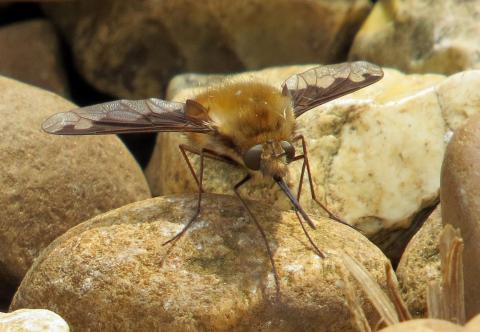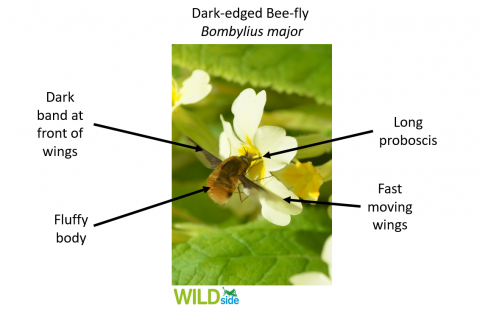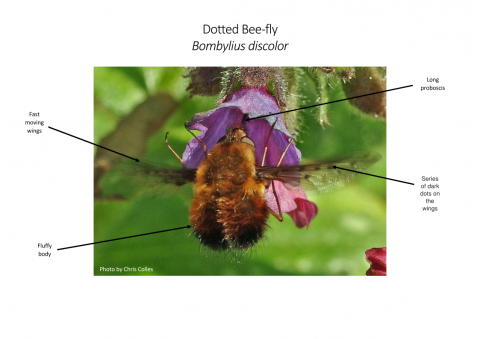It's nearly bee-fly season again and we'd like to continue with our bee-fly surveys to help map and monitor the distribution of these fascinating flies across the county. In 2018, the dotted bee-fly was recorded in Northants for the first time and we've added the option to submit a record of this species as well as your records of the dark-edged bee-fly. For an update on their distribution across the county and to learn more about their life-cycle, read the blog written by John Showers, Northants County Recorder for Diptera and submit your records to our Look out for Bee-flies survey.
The Dark-edged Bee-fly, Bombylius major, flies from March to June (most frequently in April and May) and is a widespread species of fly but there are big gaps in the county's records. We are looking for your records to help fill in these gaps!
The Dark-edged bee-fly Bombylius major can be distinguished from the Dotted bee-fly Bombylius discolor by the wing partterns. The much more common Dark-edged bee-fly Bombylius major has a dark leading edge to its wings whearas Dotted bee-fly Bombylius discolor does not have this but does have a series of dark dots on the wings. When in flight it is not possible to separate the two reliably so wait until they settle before identification and in order to confirm identification, please submit images with your record. With the discovery of Dotted bee-fly in south-west Northants in 2019 it will be very interesting to see if its range has expanded.
Dark-edged bee-flies generally like areas that are warm, have bare patches of soil and plenty of flowers. They are particlularly fond of primroses. It is an important pollinator of this species. It is common in gardens, woodland edges and meadows. When perched, this species is easily identifiable by the furry body, dark markings along the front edge of the wings and long proboscis that is permenantly extended. When flying, the dark wing edge does not show up, so check you are not looking at a bee.
The dark-edged bee fly species has a remarkable life-cylce. After mating, the female gathers fine particles from the ground and mixes them with her sticky eggs in a special pouch in her abdomen. She then flicks the eggs onto bare ground, often near the entrance holes to the nests of mining bees (Andrena species). The egg hatches into a planidium, a mobile larva, which crawls into the bee's next burrow, if it can find one. The fly larva finds the larva of a bee and then waits until the bee larva is nearly fully grown. It then attaches itself to the bee larva, and feeds on it, eventually killing it. The larva pupates and may remain in the soil for a couple of years before wriggling to the soil surface, where the adult fly emerges.
Use our form to submit records of these intriguing and charismatic species. If it is visiting flowers to drink nectar through its long proboscis, then it is useful to add a comment saying which species of wildflower it is visiting. As there are other species of bee-fly in the UK, photos are important to confirm the identification.
Please provide as much information as possible about your sighting and remember that we are specifically looking for records that fall within the Northamptonshire county boundary.
If you would like to see all the records that have been submitted to our website, including your own, please create an account before submitting your records.




